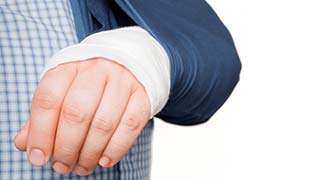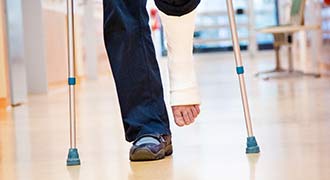If you or a loved one has sustained a fracture or broken bone from a car wreck, a slip and fall, at work, or in any case where it is the fault of another, you may be entitled to compensation for medical bills, lost wages and pain and suffering, among other things. Our firm is experienced in handling many of these cases and we charge no legal fees until you receive a settlement or award. Please call us toll free or visit us online 24/7 for a free consultation.
 Bone fractures are a common injury that can result from car accidents. Due to the high force and impact involved in collisions, these injuries can be quite severe and often require surgery. These types of injuries are classified as either traumatic or pathological. Traumatic bone breaks are usually from vehicle accidents.
Bone fractures are a common injury that can result from car accidents. Due to the high force and impact involved in collisions, these injuries can be quite severe and often require surgery. These types of injuries are classified as either traumatic or pathological. Traumatic bone breaks are usually from vehicle accidents.
The main categories of fractures are displaced, non-displaced, open, and closed. Displaced occurs when the bone snaps into two or more parts and the parts are not aligned properly. Non-displaced refers to when the bone cracks either in part or all the way through, but stays properly aligned. Open versus closed distinguishes between whether or not the bone breaks through the skin, with open being when the bone does puncture/break through the skin (also called a compound fracture), and closed it does not.
Diagnosis of Bone Fractures
Diagnosis of these injuries can be done by physical examination, x-ray imaging, or in some circumstances, where x-ray alone is insufficient, a CT scan or MRI. Although very painful, bone breaks are common and can be treated quite easily. However, they can also be very severe and troublesome to treat and lead to even more complications in the future, such as damaged blood vessels, nerves, and infection. Serious broken bone injuries that can result from car accidents include pelvic fractures, breaks of the sternum and/or ribs, and skull fractures. Other types of broken bone injuries may affect the ankle, femur, collarbone, neck, and even spinal cord-related injuries such as damaged vertebrae.
Types of fractures that commonly occur as a result of traffic accidents are:
- Comminuted
This refers to instances where the bone is splintered or crushed, and as a result, has broken into several pieces. At least three separate fragments of bone must be present in order for the injury to be categorized as comminuted. These breaks can occur as the result of tremendous force in events such as auto accidents or severe falls. These injuries are relatively easy to diagnose given that x-ray examination will show the orientation of the pieces of bone to determine the best possible course of treatment. Surgery may be required for this type of injury so that the pieces will join back together. Additional complications can arise in the event that this bone re-joining does not happen. - Buckle
Although this is not the most common of these injuries, it is still often seen in both young and elderly patients. The long bones of the body are most likely to be affected; these long bones include the ulna, radius, humerus, or femur. When an individual experiences this type of injury, the actual bone itself does not break; rather the ends of the bone are driven into each other, causing swelling and pain. This wound may also result from sudden trauma, accident, or a fall. Diagnosis is typically done by x-ray, and treatment usually involves a cast to keep the bone stable, reduce any swelling, and relieve pain. - Transverse
These injuries are sustained when the bone is completely broken in a direction perpendicular to the way the bone runs. Basically, the break crosses the bone completely, separating the bone into two pieces. X-ray imaging can reveal whether an individual has sustained this type of split. Due to the full break of the bone, healing and recovery times tend to be longer. The bone can be set either externally by repositioning without surgery, or by repositioning with surgery. In either treatment course, a cast is needed for immobilization. Immediate medical attention is important for ensuring the bone is successfully set. - Oblique
This is an injury in which the fragmentation line runs diagonally along the length of the bone. These breaks are most often caused by trauma to the bone coming from a slanted angle of impact. Treatment is dictated by the severity of the injury, although typically involves a splint to stabilize the area of injury until the swelling goes down. A cast or surgery may be necessary in some instances to ensure the bone stays stable long enough to heal. - Greenstick
This term refers to cases where an individual’s bone bends or cracks, but does not actually break into separate pieces. The outlook for these injuries is good as they generally heal rather quickly. Common causes include both trauma and falls. To treat this type of injury, the bone must be straightened back out and immobilized with a cast for further healing. In very rare cases, surgery may be required, but more often than not, a full recovery can be made in as little as three weeks.
Signs and Symptoms of Fractures
- Inability to move the injured area
- Inability to put weight on the injured area
- Swelling
- Bruising
- Deformity of the area
- Pain in the injured area that gets worse with movement or pressure
- Loss of function in the injured area
- Bone protruding from the skin (in the case of an open fracture)
Treating Fractures
 Following any breakage of bone, that bone must be repositioned or set. In some cases, the bone can be set without the patient having to undergo surgery (closed reduction), followed by immobilization of the area using either a cast or splint. More serious instances may require surgery (open reduction) and setting of the bone using pins, plates, screws, rods, and glue. In either event, once the bone has been set, rehabilitation is important, and then a gradual return to use of the area again. In the cases where the bone broke through the skin, antibiotics can be used to prevent infection.
Following any breakage of bone, that bone must be repositioned or set. In some cases, the bone can be set without the patient having to undergo surgery (closed reduction), followed by immobilization of the area using either a cast or splint. More serious instances may require surgery (open reduction) and setting of the bone using pins, plates, screws, rods, and glue. In either event, once the bone has been set, rehabilitation is important, and then a gradual return to use of the area again. In the cases where the bone broke through the skin, antibiotics can be used to prevent infection.
Experience in Handling these Cases
The car accident attorneys at d’Oliveira & Associates have experience handling cases where motor vehicle accidents result in injury. In one instance, our firm worked jointly with another trial attorney and reached a $1 million settlement for a client who was injured in a motor vehicle accident and suffered fractured vertebrae in her spine. In another case, where a client was struck by another vehicle as a pedestrian and suffered bone breaks to her face among other injures, we were able to recover a $775,000 settlement.
Contact the Law Offices of d’Oliveira & Associates
 If you or a loved one has sustained a broken bone injury in an auto accident, at work or due to the fault of another, you may be entitled to a settlement. By contacting a personal injury attorney, you can ensure that your legal rights are protected. We handle many of these cases on a regular basis and there is no fee unless you receive an award or a settlement. Call us today at 1-800-992-6878 or fill out an online contact form for your free legal consultation.
If you or a loved one has sustained a broken bone injury in an auto accident, at work or due to the fault of another, you may be entitled to a settlement. By contacting a personal injury attorney, you can ensure that your legal rights are protected. We handle many of these cases on a regular basis and there is no fee unless you receive an award or a settlement. Call us today at 1-800-992-6878 or fill out an online contact form for your free legal consultation.
